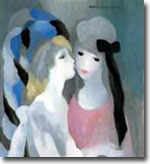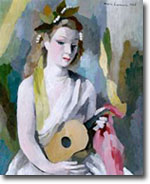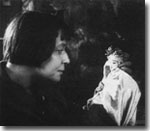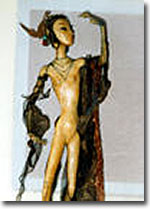Out Take One: The Forebears Angelika Hoerle’s heritage dates back to the 1700s in Pomerania. The story of her forebears foreshadows the talents and influences that shaped her and her time period.
Before Michael Fick turned fourteen in 1815, his small town of Falkenberg in Pomerania changed hands several times—a bouncing ball that Prussia, Sweden and France kicked around during their war games. Fortunately Michael did not worry about the vagaries of wars as he had married well into the inn keeping family of Marie Louise Charlotte Glaese from Massow. Armies passing through meant prosperity. Michael, literate and good at numbers, wielded his assay scale with expertise to test the coins of the various metals that gentlemen travelers and army officers from nations across Europe offered the accommodating innkeeper. Due to his keen business sense and the fine table set by good wife Marie Louise, life was good for the Fick family. Michael lived comfortably to the age of 70, long enough to see the end of the last Napoleon. Michael Fick was laid to rest in Massow in 1871 just as William I, King of Prussia, was proclaimed German Emperor in the splendour of the Palace of Versailles. Marie and Michael’s son Wilhelm Carl August Fick, born when Michael was 32 years of age, came into the world Dec. 1, 1833 in the year that Gauss and Weber devised the telegraph. The 1848 rebellions throughout Europe strengthened Marie and Michael’s resolve to keep their son safe in agricultural Pomerania. Although this first Willy Fick did not inherit his parents’ inn in Massow , his parents assisted his career as cattle merchant in the fertile land that the Oder River had carved out over millennia as it emptied into the Baltic Sea. Willy Fick was well established at 26 years of age when in the deep of winter 1859, he took as his bride Maria Amalie Levin, the 21 year old daughter of Friedrich Wilhelm Levin of Stargard, one of the larger towns in the area that served as a railroad hub. The elder Levin, born in 1788, the year Mozart composed the “Jupiter” Symphony, freely gave his daughter to the prosperous young cattle merchant from Massow not expecting that she would be widowed a mere 12 years later. When Willy Fick died unexpectedly at 38 years of age, he left the 33 year old Maria with three children between the ages of eight and eleven: Richard, Wilhelm and Amalie. The widow Maria Amalie, could not return home to Stargard as her 83 year old father was ailing and indeed died the next year. Her father-in-law’s death in the same year as her husband made the situation dire. She could not assume her husband’s work as cattle trading was a man’s business. Maria looked at her three young children, still in school, and rued that she could not provide the improved future of which she and Wilhelm had dreamed. Maria’s eldest son Richard, took over leadership of the family to the best of his ability. Maria’s brother August Levin helped out as much as he could. The long-term solution seemed to be to find a new husband for Maria Amalie –which was done after a suitable time of widowhood. Maria Amalie married a Mr. Renntzmann who was keener to be a husband than a father. He wanted to start a new life in America without Maria’s children. By April 1878 Richard August Michael Fick was apprenticed as a cabinet maker in Falkenberg. Over the next six years, he learned his trade in 13 different locations from Massow, Stettin and Potsdam to Namby and Dibbersen. The young Richard, often impatient with working conditions, stayed in some placements for only three or four months. In May of 1884 when he was finally a qualified cabinet-maker, his mother Maria Amalia Renntzmann was living in Rich Hill, Missouri, his sister Amalie was married in Massow and his brother Wilhelm had migrated south to Cologne. Richard decided to join his brother in Cologne where rapid industrialization made work opportunities that didn’t exist in the rural areas of Pomerania. In 1867, at the World Exposition in Paris, Krupp’s Giant 1000 pounder cannon had drawn as much awe as Eiffel’s Tower--it was a changing world. A woodcut of Elberfeld in 1882 showed the Mechanical Weaving Factory Boeddinghausen with other factories in the distance. The industrial Rhineland in the 1880’s was ready to absorb a qualified worker like Richard Fick. While the fortunes of the Fick family waxed and waned in Pomerania, the Kraft family in the Rhineland was strictly ascending. Peter Hubert Kraft, born in 1834 in Randerath, northwest of Cologne, climbed through the hierarchy of the expanding Deutsche Bahn to reach the position of Chief Lading Officer in one of Cologne’s busiest Railroad Stations. Described as upright and open in character with precision of knowledge and a deep sense of duty, he was much beloved by everyone. In 1862 Peter Kraft married Anna Maria Caspers of Rondorf. She was 27 to his 28 years of age. The only anomaly in their staunch, well-lived Catholic lives was that Anna delivered their first child, Anna Maria Kraft, a mere four months after their wedding in Cologne. In all, the couple had six children, four sons and two daughters. Anna and Angelika, the two beautiful Kraft daughters, were raised in middle class splendour. Their home was full of music and literature. There were cultural outings and much was made of the latest finery in clothes. All the Kraft children played at least one musical instrument. Sheet music and railroad schedules underpinned the home’s operations. Railroad holidays punctuated their lives. All was going well for the two Kraft beauties when Angelika Kraft, met the aspiring young architect, Johannes Reif from Hamburg. Anna had already met the handsome Fick brothers Richard and Wilhelm and had been smitten by the confident and worldly Richard. As a cabinet-maker Richard did not rank as high in their parents’ estimation as Angelika’s architect beau. In the end, love triumphed. On Feb 9, 1889 in the St. Gereon Church in Cologne, Anna Maria Kraft married Richard August Michael Fick in a lovely ceremony sponsored by the bride’s parents. Shortly after her sister’s wedding, Angelika and Johannes Reif returned to Hamburg while uncle August Levin and Richard’s sister Amalie and her family returned to Massow. Maria Amalie Levin Fick Renntzman, the mother of the groom, did not attend. She had started a new life in Missouri. These decades of family history during the turbulent political and economic times from 1800 to 1890, set the backdrop for the arrival of the Fick children, the artist Wilhelm Peter Hubert Fick born in 1893 and the artist Angelika Margaretha Fick born in 1899. The values in the home where Willy and Angelika grew up had been finely honed by their ancestors as they had made places for themselves in the world. These ancestors had been landowners, literate, skilled, respected and religious. Their talents included being good at numbers and music. Their interests were the arts and the well being of the working man. Had Willy and Angelika Fick been children of Michael and Marie Fick in Pomerania at the beginning of the 19th century, instead of children of Richard and Anna Fick at the end of that century, the family expectations would have differed little. As the Fick children grew up during the beginning of the 20th century, they drew upon the talents and resiliency of their forebears, to give vision, voice and witness not just to what the world was, but also to what it should be. |
“The Developing Artists 1912-1914” Outtake from the Manuscript Angelika Hoerle: The Comet of Cologne Dada (AGO 2009 exhibition) Things started to percolate for Angelika and Willy Fick in 1912. Willy began evening and Sunday courses in drawing and architectural drafting at Cologne’s Kunstgewerbe School. Angelika did all his assignments with him. During the two years that Willy took classes he met Franz Seiwert, Heinrich Hoerle, Anton Raederscheidt and Marta Hegemann who were there either in full or part time studies. The Kunstgewerbe circle started to overlap with that of the Gereonsclub creating a heightened atmosphere of creative interaction—all of which reverberated in the Fick home.
1912 was filled with exciting enticements for a 12-year-old but as yet she was only a pre-teen working on her brother’s art school assignments and going to art exhibitions with him. She matured during 1913 and 1914 as she continued to find great stimuli in the Rhineland arts scene. Kaethe Kollwitz works were at the Cologne Kunstverein and Marie Laurencin works at the Galerie Flechtheim in Duesseldorf. The Cologne Secession formed in 1912 had a very important exhibition at the Art Salon Cohen in Bonn in 1913. Some of the artists displayed were now familiar to Angelika through the Gereonsclub and her brother Willy. The synaptic connections that formed the core of a Cologne arts coterie kept firing in the exciting pre-war years. Artists met in studios, coffee houses and at exhibitions and events. In 1913-14 Hoerle had a studio in his parents’ home on Erftstrasse where he and Max Ernst worked. The vortex of the growing group of artists, poets, writers, architects and academics was the Cafe Luna in Cologne where coffee klatches covered a great deal of territory. In Jan 1914 the German Theatre in Cologne presented Maeterlinck’s marionette play Death of Tintagiles. Maeterlinck’s marionettes portrayed his view that fate pulled man’s strings. Kandinsky attended the premiere at the theatre where he had a one man show. At this point in time he labelled many of his abstract works concerts and improvisations. The changing nature of music was the subject of discussion when Schoenberg, whose art had been at the Gereonsclub, had his Chamber Symphony #9 performed in February, 1914. The Cologne Stadtanzeiger review was titled “Cannibalism in Music”.
Below is the impossibly long link to the German version of the Polish blogspot on Angelika. |
Angie Littlefield | 416.282.0646 | angie.littlefield@yahoo.ca

 Then came the Cologne Sonderbund, also in 1912. The impact of this international exhibition featuring 577 paintings and drawings and 56 sculptures is well documented in the lives of artists such as Max Ernst and Heinrich Hoerle. These artists were inspired by the exposure to great men of the European avante-garde. Angelika Fick noted that great women were present as well. She was enchanted by the fashionable ladies of Marie Laurencin and impressed by the massive sculptures of Milly Steeger who at the time was working in Hagen for one of the Sonderbund’s organizers. Karl Ernst Osthaus planned to create a community representing the ideal synthesis of the arts and architecture.
Then came the Cologne Sonderbund, also in 1912. The impact of this international exhibition featuring 577 paintings and drawings and 56 sculptures is well documented in the lives of artists such as Max Ernst and Heinrich Hoerle. These artists were inspired by the exposure to great men of the European avante-garde. Angelika Fick noted that great women were present as well. She was enchanted by the fashionable ladies of Marie Laurencin and impressed by the massive sculptures of Milly Steeger who at the time was working in Hagen for one of the Sonderbund’s organizers. Karl Ernst Osthaus planned to create a community representing the ideal synthesis of the arts and architecture. By 1912 Angelika had grown to a lanky young woman with a prodigious interest in the arts. The careers of Kaethe Kollwitz, who she had first seen in Licht und Schatten, Marie Laurencin, and Milly Steeger were as impressive to her as the organizing capacity of Emmy Worringer’s and Olga Oppenheimer for the Gereonsclub. In 1912 the club featured the Blue Rider, Paul Klee, William Worringer reading from his thesis Abstraction and Empathy (1908), Theodor Daubler reciting from his lengthy poem Das Nordlicht and the composer Arnold Schoenberg showing his artistic works. Even though Angelika would not have attended all these events, they were highlights of the Cologne avante-garde.
By 1912 Angelika had grown to a lanky young woman with a prodigious interest in the arts. The careers of Kaethe Kollwitz, who she had first seen in Licht und Schatten, Marie Laurencin, and Milly Steeger were as impressive to her as the organizing capacity of Emmy Worringer’s and Olga Oppenheimer for the Gereonsclub. In 1912 the club featured the Blue Rider, Paul Klee, William Worringer reading from his thesis Abstraction and Empathy (1908), Theodor Daubler reciting from his lengthy poem Das Nordlicht and the composer Arnold Schoenberg showing his artistic works. Even though Angelika would not have attended all these events, they were highlights of the Cologne avante-garde.  The opening of the Cologne Werkbund exhibition in May 1914 was yet another marker for the Cologne arts scene. Van de Velde’s Theatre, Gropius’ Factory and Bruno Taut’s Glass House were marvels of design and material. Karl Ernst Osthaus was once again at the helm, this time for an astounding display of German applied arts. Angelika Fick was most certainly drawn to the House of Women where Milly Steeger had organized the display of the works of twelve female sculptors. There were batik fabrics, wall hangings, rugs and even linoleum floor designs by women. The Cologne Stadtanzeiger reviewer had special praise for Lotte Pritzel’s wax dolls which he described as having an almost demonic attraction.
The opening of the Cologne Werkbund exhibition in May 1914 was yet another marker for the Cologne arts scene. Van de Velde’s Theatre, Gropius’ Factory and Bruno Taut’s Glass House were marvels of design and material. Karl Ernst Osthaus was once again at the helm, this time for an astounding display of German applied arts. Angelika Fick was most certainly drawn to the House of Women where Milly Steeger had organized the display of the works of twelve female sculptors. There were batik fabrics, wall hangings, rugs and even linoleum floor designs by women. The Cologne Stadtanzeiger reviewer had special praise for Lotte Pritzel’s wax dolls which he described as having an almost demonic attraction.  Angelika Fick finished Volkschule shortly after the Werkbund exhibition. Unlike her sister Maria, she did not wish to continue. Angelika wanted an apprenticeship like her brothers as she coveted the freedom that working brought. Her traditional father acquiesced to the decision when an apprenticeship in millinery was found.
Angelika Fick finished Volkschule shortly after the Werkbund exhibition. Unlike her sister Maria, she did not wish to continue. Angelika wanted an apprenticeship like her brothers as she coveted the freedom that working brought. Her traditional father acquiesced to the decision when an apprenticeship in millinery was found.